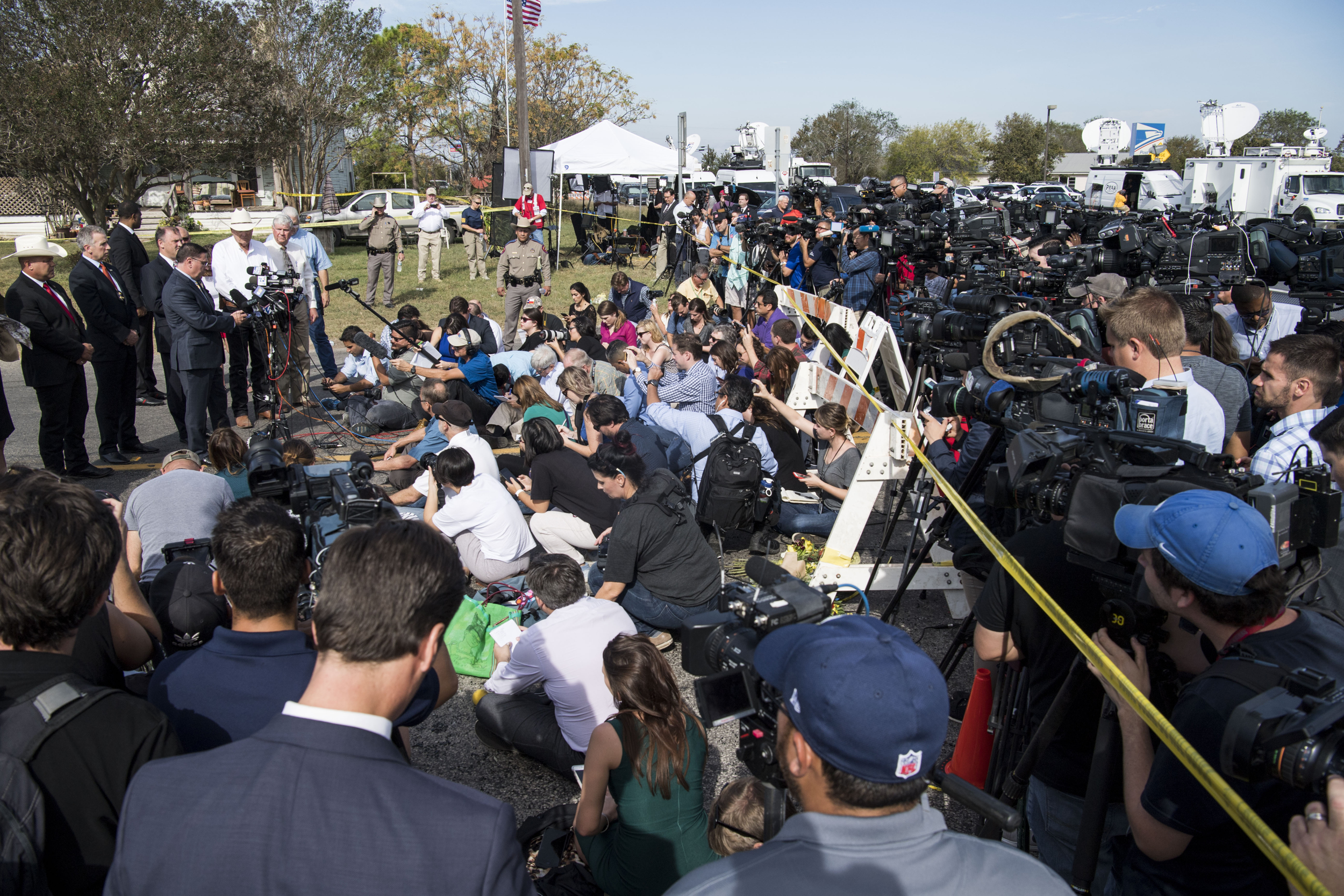Sign up for the daily CJR newsletter.
In the wake of last weekend’s mass shooting at a church in Sutherland Springs, Texas, Dallas Morning News reporter Lauren McGaughy wrote a widely shared op-ed taking to task the news media that swarmed the town of just under 700 people. She described how the massed ranks of regional, national, and international journalists overwhelmed the traumatized local community with TV trucks, microphones, and invasive, repetitive questions. “At the prayer vigil Sunday night, mourners clutching candles hugged each other and sobbed. The pictures were beautiful,” McGaughy says in her open letter to the town. “What you didn’t see was the scrum engulfing your friends and loved ones, photographers and reporters with iPhones jockeying to capture an image that didn’t also include the media melee.”
McGaughy ended her piece with an urgent call for newsrooms to discuss how they might better approach the aftermath of mass trauma—especially in small towns where nearly every resident is in some way personally affected, and where the invasion of the global media can double the population overnight. McGaughy says she’s received many messages in response to her op-ed suggesting ways for the press to still get the story while treating grief-stricken communities with respect. She also got pushback from reporters grumbling that they were just doing their jobs.
ICYMI: Site sparks uproar on social media with Vegas massacre headline
It’s important for the media to cover mass shootings in as much detail as possible—because such atrocities tie into critical debates on gun laws, and because no murder or act of terrorism should be normalized or forgotten. People in the affected communities often agree, and many of them want to tell the world what happened. But they want to do so on their own terms, not at the whim of pushy reporters. Many journalists understand the moral quandaries of on-the-ground reporting in the wake of trauma. But the pressing imperative to get a scoop or quote sometimes gets in the way, while the horrifying regularity of gun violence in America can have a broader desensitizing effect.
Debates on how best to cover mass shootings aren’t new, but they rarely propose concrete steps newsrooms and reporters could take to avoid overwhelming grieving communities. In that vein, CJR spoke with reporters, editors, and experts on how the press might do better. These ideas are points for discussion, not ready-to-implement panaceas. But the conversation has to start somewhere. As Nicole Dahmen, an expert on mass shootings and the media at the University of Oregon, puts it: “We hear from every single community, every single time one of these shootings happens, that the media coverage was a second trauma.”
1. Better training for journalists on the ground
The easiest way to improve interactions with grieving communities would be for newsrooms to provide reporters with better training before putting them on the beat. In Sutherland Springs, McGaughy says residents she spoke to “felt common decency and manners went out the window.”
“We’re taught in this profession that persistence is important, and I think that’s true when we talk about public corruption, politics, and the like,” she tells CJR. “But when we’re talking about a grieving community, the playbook changes.”
ICYMI: A feud between two media giants
Beyond intuitive sensitivity and basic manners, newsrooms could lay out clear protocols for staff. If a survivor or bereaved relative doesn’t want to talk, offer them a number to call if they change their mind, but don’t try back later. If they do grant an interview, take a moment to apologize for their loss before you start asking questions, and let them know they can back out any time—but don’t feign understanding or sympathy. Outside organizations like the Dart Center for Journalism and Trauma at Columbia Journalism School already offer tip sheets that newsrooms could use as a starting point.
Reporters who themselves feel emotionally supported are likely to be more respectful, and more effective, when interviewing victims and their families.
As well as laying down rules for reporters, outlets should check with staff regularly to make sure they’re okay, and rotate them out if they’re showing signs of strain. “This is partly an ethics question about how we treat the public, but it also has an occupational health association,” says Dart Center Executive Director Bruce Shapiro. The two imperatives are linked; reporters who themselves feel emotionally supported are likely to be more respectful, and more effective, when interviewing victims and their families.
2. Cooperating with local media
Newspaper, TV, and radio networks could lean more heavily on local affiliates and correspondents, who are often first on the scene, but are then expected to take a back seat as weightier names from higher up the food chain fly in. Outlets should show more faith in their local talent. If editors feel local affiliates are falling short, they could send in an experienced producer, rather than an extra reporter to shove a microphone in people’s faces.
Mass shootings are huge news events that can have divergent local and national strands—so it is often necessary to send in reinforcements from other bureaus. This works best when parachutes work under or in equal partnership with their affiliates. “We were working very closely with Texas Public Radio in Sutherland Springs, coordinating our efforts to make sure we weren’t doubling up and knocking on the same doors,” says NPR’s Southern Bureau Chief Russell Lewis. “We made sure each of the people were covering different events and different services, and we were sharing tape and information so we didn’t end up at the same places.”
RELATED: An analysis of Las Vegas shooting headlines reveals unsettling trends
Even in the absence of a corporate relationship, national media could work more closely with independent local news organizations, which often have a better understanding of the context of a crime, as well as better access to official information due to long-term relationships with authorities. National outlets could coordinate reporting efforts, with local editors serving as sherpas for the local environment, or simply link out to great work in lieu of sending extra reporters to the scene. As improbable as this scenario might sound, there’s a benefit beyond pure altruism. National outlets talk frequently about the sad decline of local news; they could earn industry kudos by supporting it.
3. Pooling reporters and resources
Even where local outlets are poorly resourced or simply don’t exist, national news outlets don’t all have to flock to the scene en masse. It’s long been a principle of political reporting, for example, that outlets take turns sending a pool reporter to cover a presidential trip overseas.
It’s highly unlikely that major news outlets would agree to stand down their reporters in the absence of official limits to access; after all, knocking on a bereaved relative’s door isn’t like boarding Air Force One. And there are other arguments against the strategy. While Reuters Editor in Chief Stephen Adler is sympathetic to the difficult consequences of the swarm effect in small towns, he says any sort of organized pool system in such cases would be dangerously close to self-censorship. “What if you’re keeping the most insightful journalist out of the location?” he asks. (Adler chairs CJR’s Board of Overseers.)
But a pool system could be in news outlets’ self-interest. Racing to send reporters and resources to unfamiliar terrain can be an expensive operation. “It’s the most ridiculous thing, from a cost point,” says California public radio host John Sepulvado, who has reported on several mass shootings. “All the press is doing is overwhelming people, and then they’re all competing with each other, and that’s when the objectification [of local people] comes.”
At the very least, newspaper photographers and TV and radio stations could share pictures and tape from the ground to avoid clogging up parking lots with satellite vans and cramming into memorial services in pursuit of the same scene. Sharing TV equipment, in particular, would significantly reduce the media’s footprint, given the disproportionate numbers of support staff needed to run a live broadcast.
4. Just don’t go
It’s a journalism school truism that the best reporting is always done from the scene. But effectiveness diminishes when subjects are so overwhelmed that they don’t want to talk to the press. It’s not uncommon for residents to get out of town the few days after a shooting to avoid the inevitable procession of reporters with identical questions.
Much would be lost if every outlet worked remotely, but that doesn’t mean individual organizations shouldn’t ask themselves, on a case-by-case basis, whether their presence would add anything to the public’s understanding of what happened. Some newsrooms have shown themselves capable of reflective self-restraint around shootings—weighing whether and when to name perpetrators after studies showed doing so could inspire copycats.
Much real-time coverage of mass shootings is driven by central newsrooms already, meaning it wouldn’t be a radical move for a news organization to unilaterally make all its coverage of an event remote. Residents can be reached on social media and by phone almost as easily as in person, in a way that can feel less immediately intrusive if done with sensitivity and without insistence.
Covering shootings from a distance could also breathe new life into citizen journalism. Newsrooms already look for, verify, and link out to social media videos and posts showing what happened on the ground, even if the model is less in vogue than in years past. “It’s a way to get authentic local voices into a story without literally going and pounding on their doors and getting a quote they’ve already put on Facebook,” says Justin Peters, a former CJR staffer who now writes for Slate.
5. If you go, look for the deeper story
The news cycle in the aftermath of a mass shooting can take an eerily repetitive tone: Journalists turn up to the scene, piece together what happened, get emotive interviews, file, and leave—all as a circular debate on gun control swells then fades in their wake. Even if news organizations can’t or won’t take action to end the swarm effect, they could serve distraught communities better than rehashing a clichéd news cycle for a week then moving on to the next thing.
Rather than insisting on a set formula for a story, outlets could give their reporters more leeway to follow their instincts on the ground. Instead of getting a set number of quotes or a scoop to beat an immediate rival, reporters could usefully hang back, observe rather than intrude, then write up a more naturalistic assessment of citizens’ response to tragedy—as Peters did for Slate in the wake of the Sandy Hook Elementary School shootings in Newtown, Connecticut.
https://www.gettyimages.com/license/857660460
Journalists could wait for sources to come forward to tell their stories, without making first contact or applying pressure. Sepulvado’s suggestion that reporters stand outside trauma centers with signs inviting people to talk might seem farfetched at first impression, but it isn’t so different from the way the press was cordoned off at funerals following Sandy Hook. “People could choose to go over and speak to the press if they wanted to, and that was the audio that I got,” says Craig LeMoult, who covered the shootings for WSHU Public Radio. “My approach in Sandy Hook was not to reach out directly to the families of victims.”
People respect when you don’t treat these shootings like some sort of grim routine, but as uniquely horrific.
Like many local reporters, LeMoult didn’t stop covering Sandy Hook at the end of the initial news cycle. Once parachutes pack up their vans to go back to New York or LA or DC, it’s the papers and stations on the ground who ensure tragic stories aren’t forgotten. Some national reporters should consider sticking around, too—and not just dropping back in to cover a trial or one-year anniversary.
The Washington Post often sends Eli Saslow to write features on how communities cope once the glare of media attention fades. “Our attention span as a country is so short that the wave of interest ends really quickly, and the people feel, first, relieved, but then a little bit abandoned,” he says. “People respect when you don’t treat these shootings like some sort of grim routine, but as uniquely horrific.”
Staying put isn’t an option for many reporters, of course. But if even one or two national journalists stay, it could help members of the community feel, in the final count, that the news media respects them and takes their grief seriously. It’s an action, Saslow says, that breeds reciprocal respect for the reporter. “You stop becoming part of this huge media apparatus, and you start becoming a person.”
RELATED: The phrase journalists used to describe Vegas shooter, and the ‘unspoken implication’
Has America ever needed a media defender more than now? Help us by joining CJR today.







